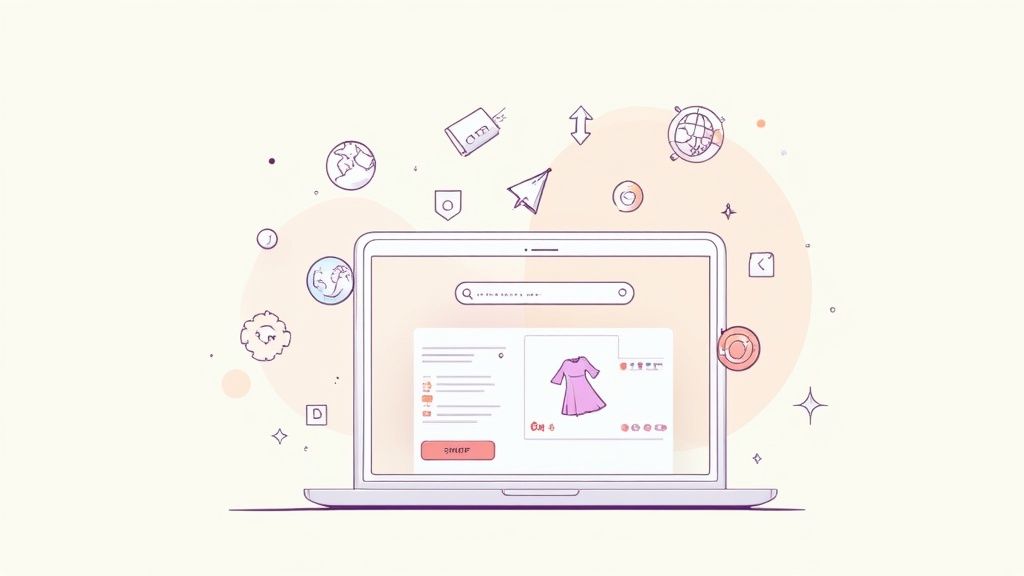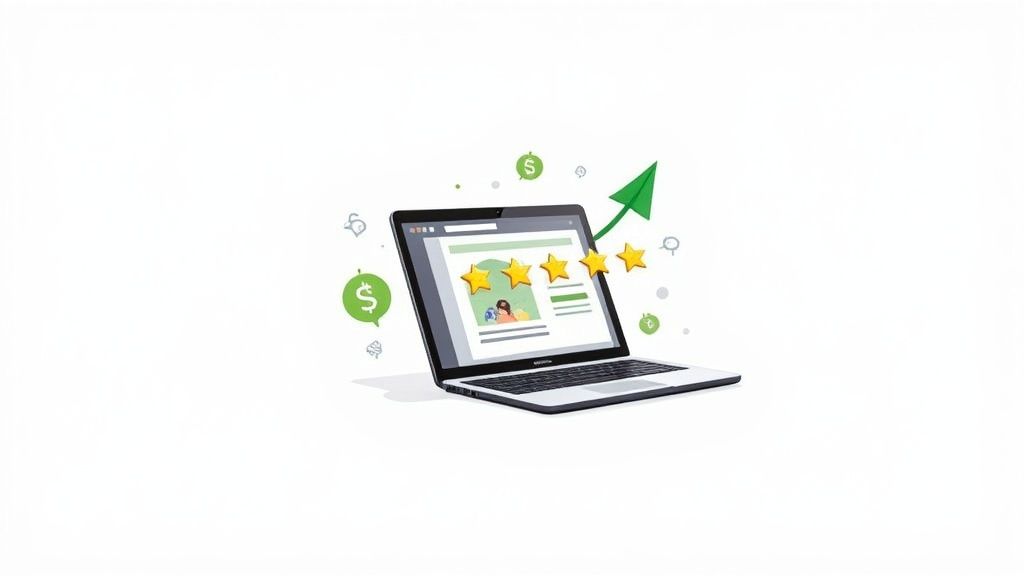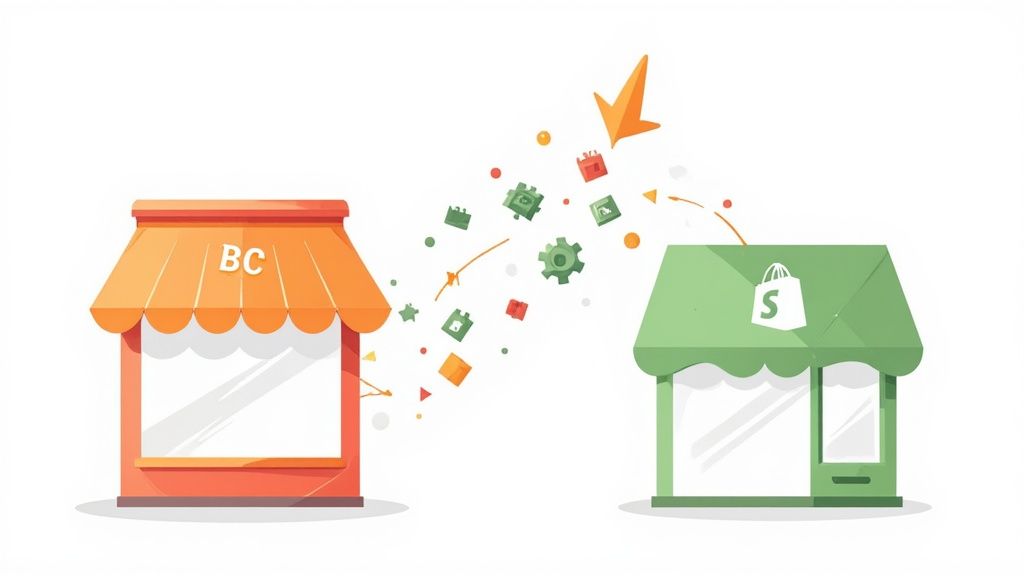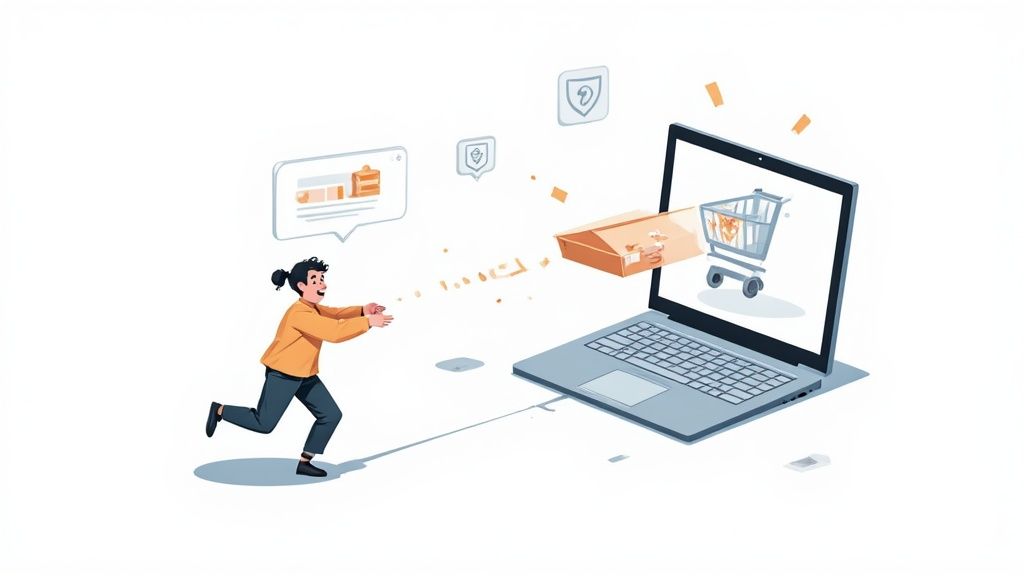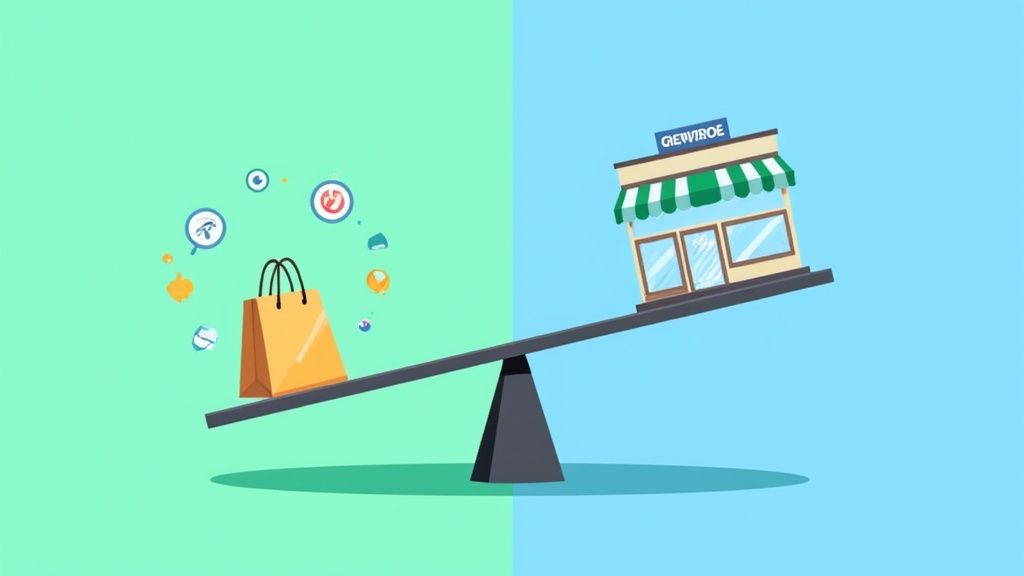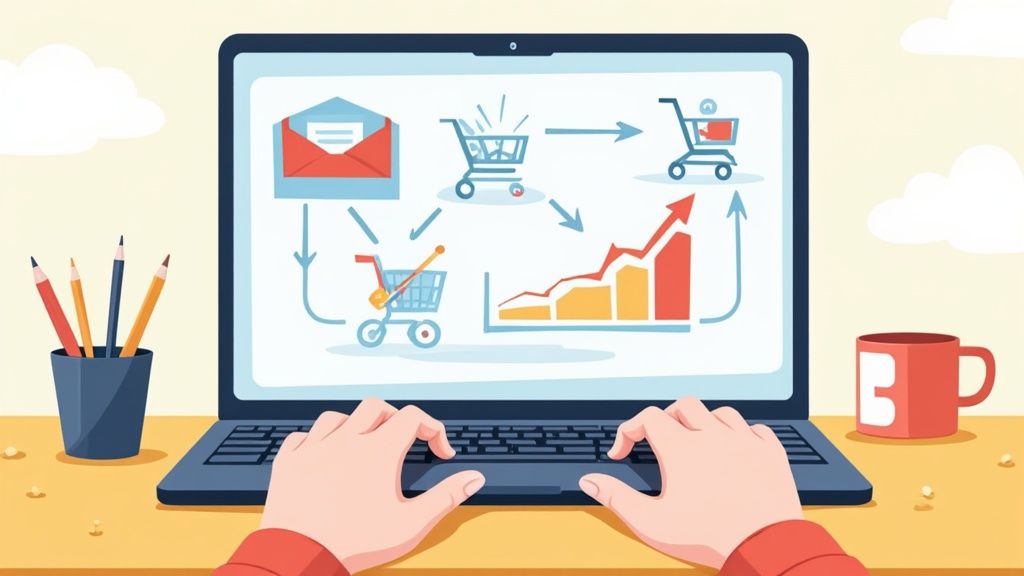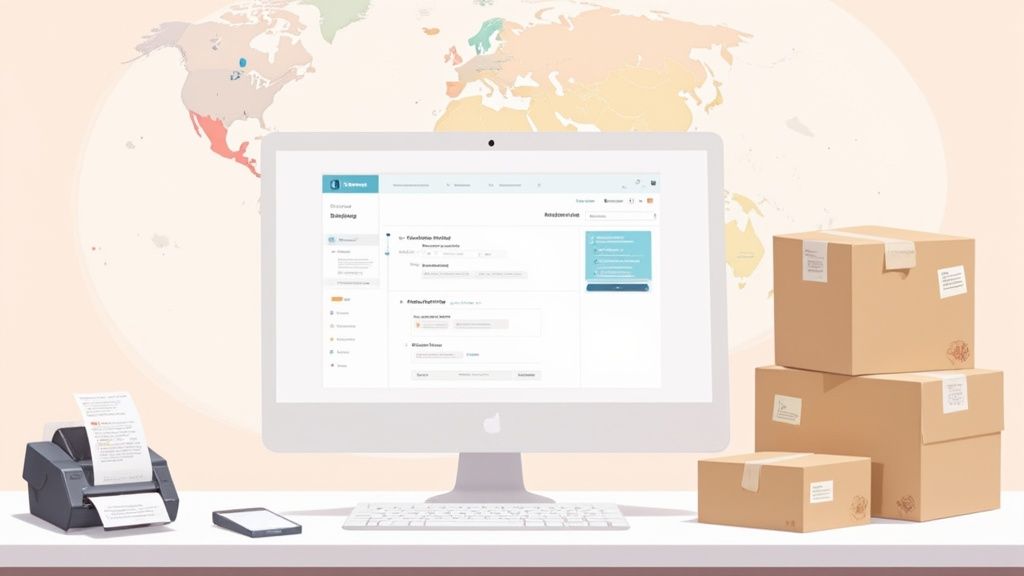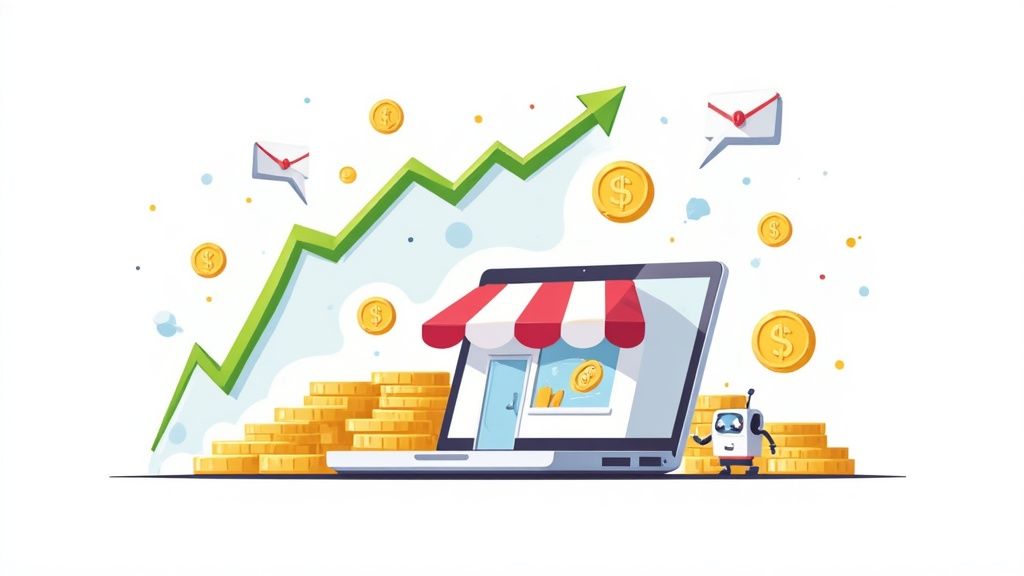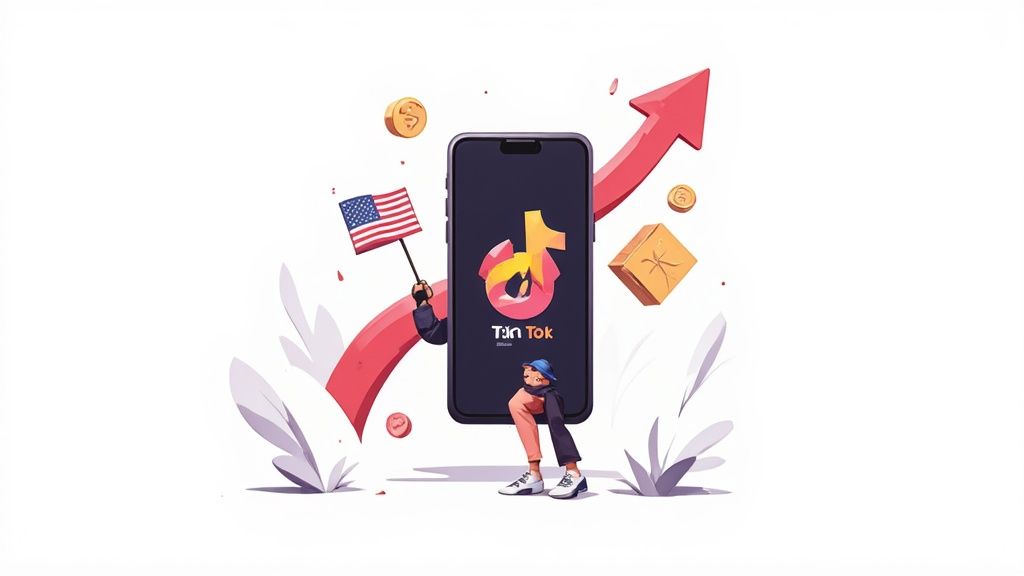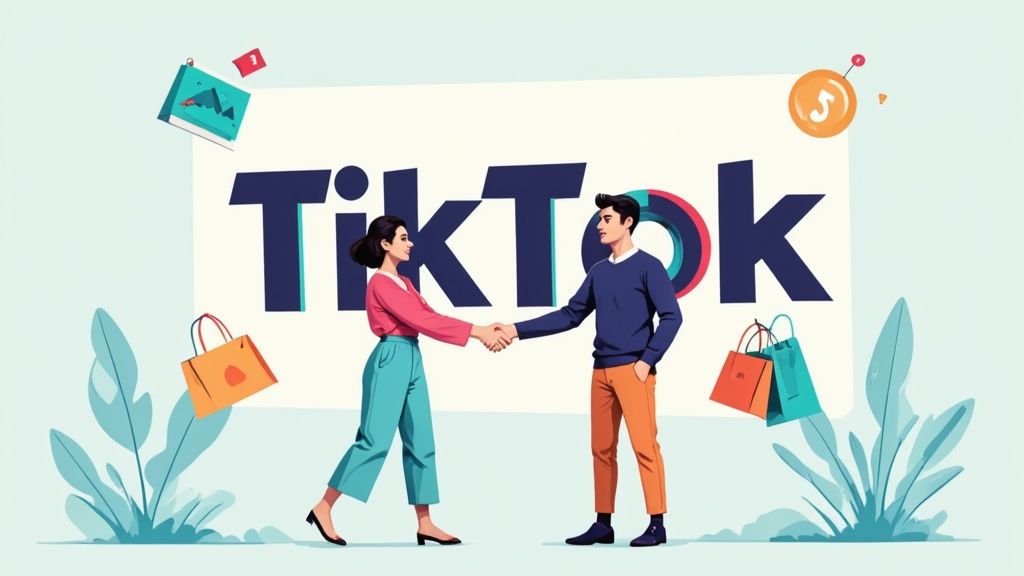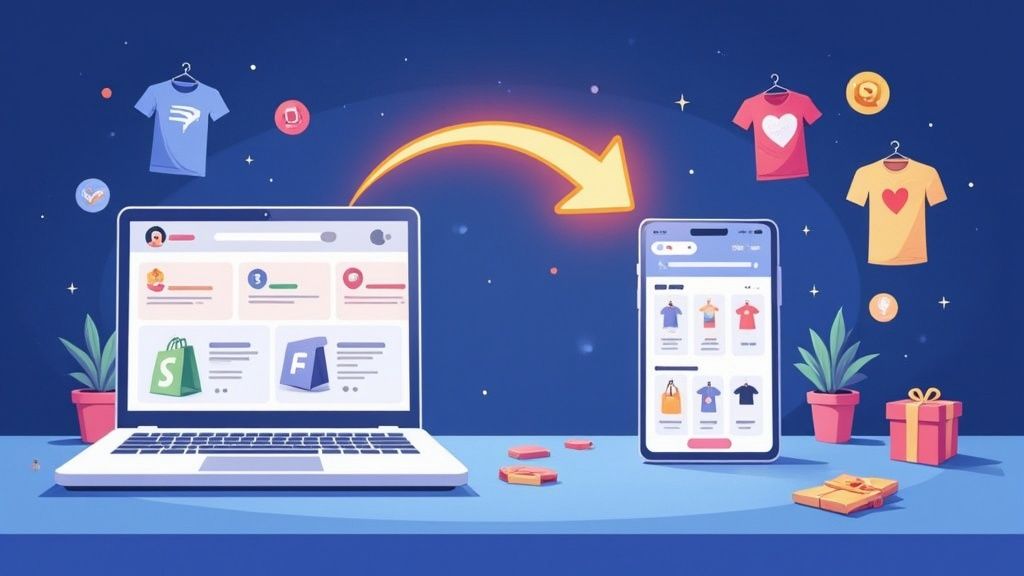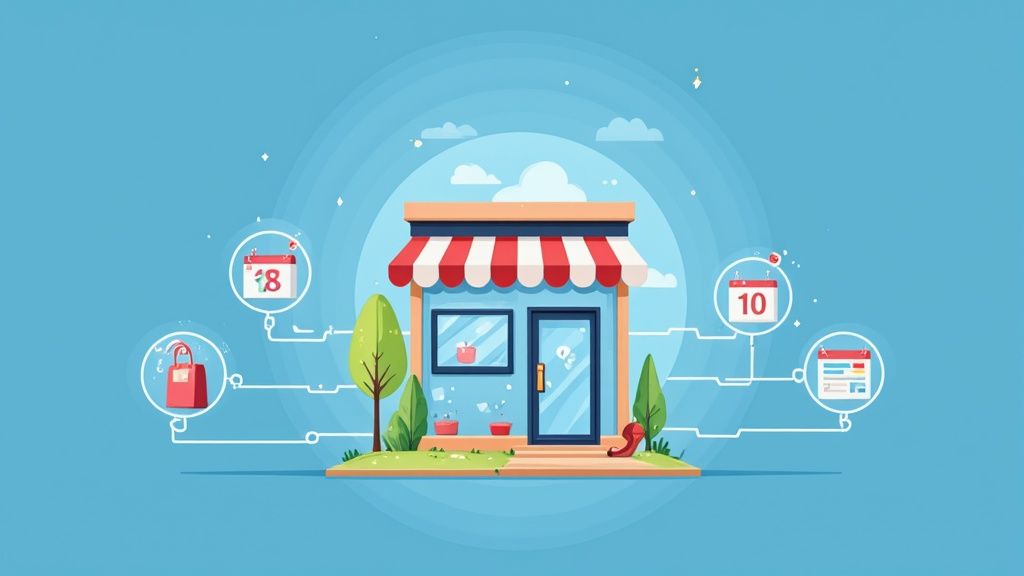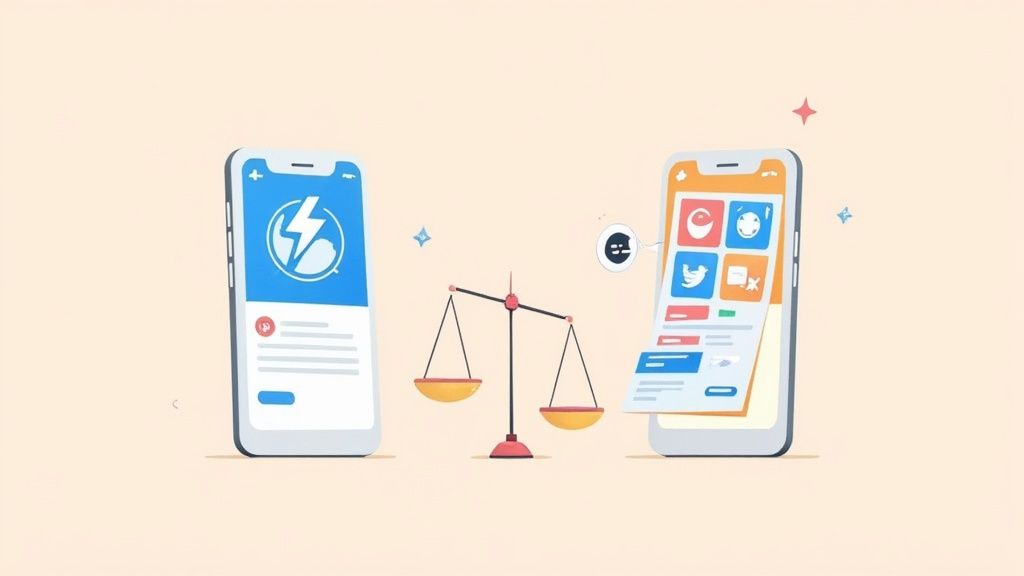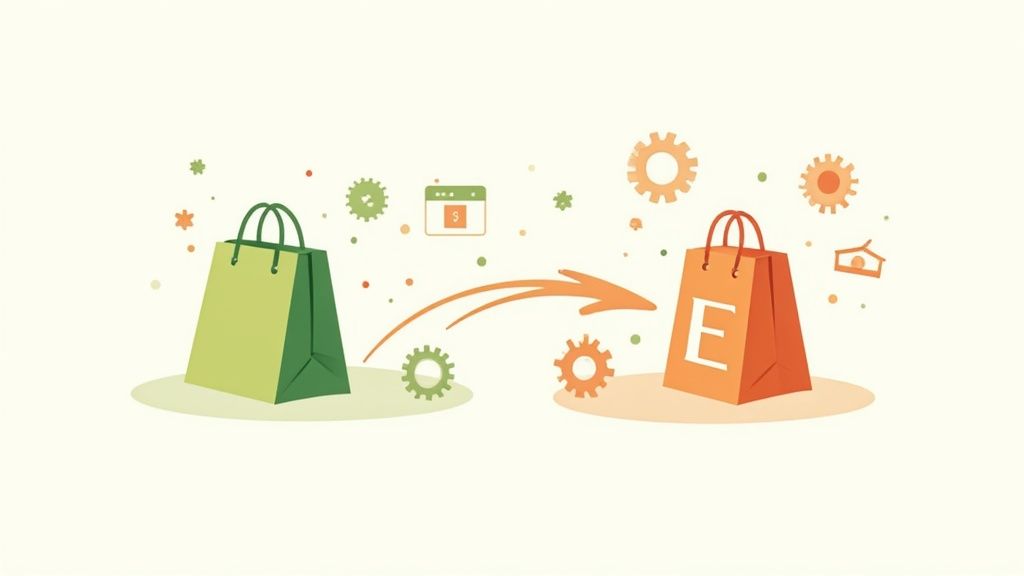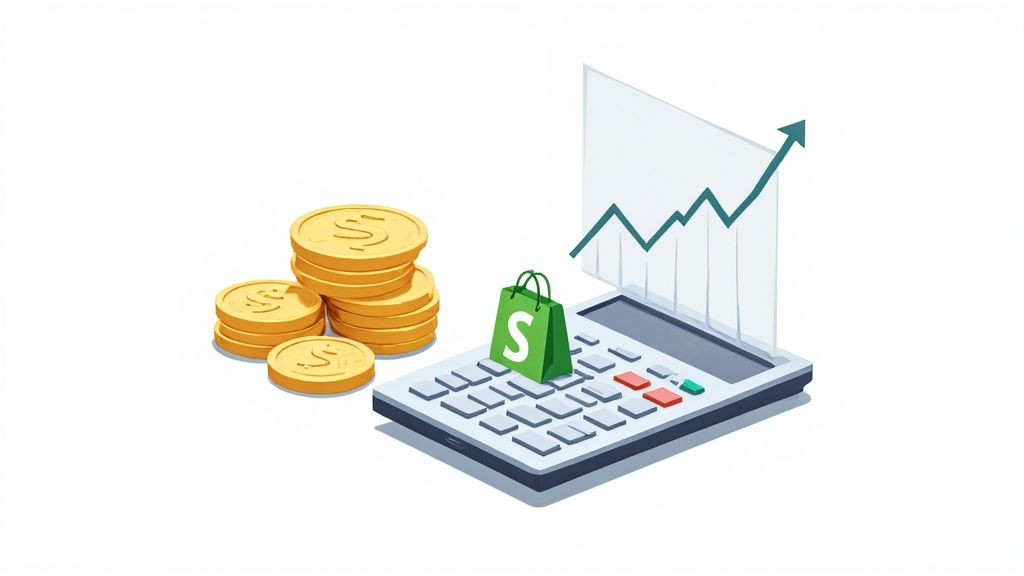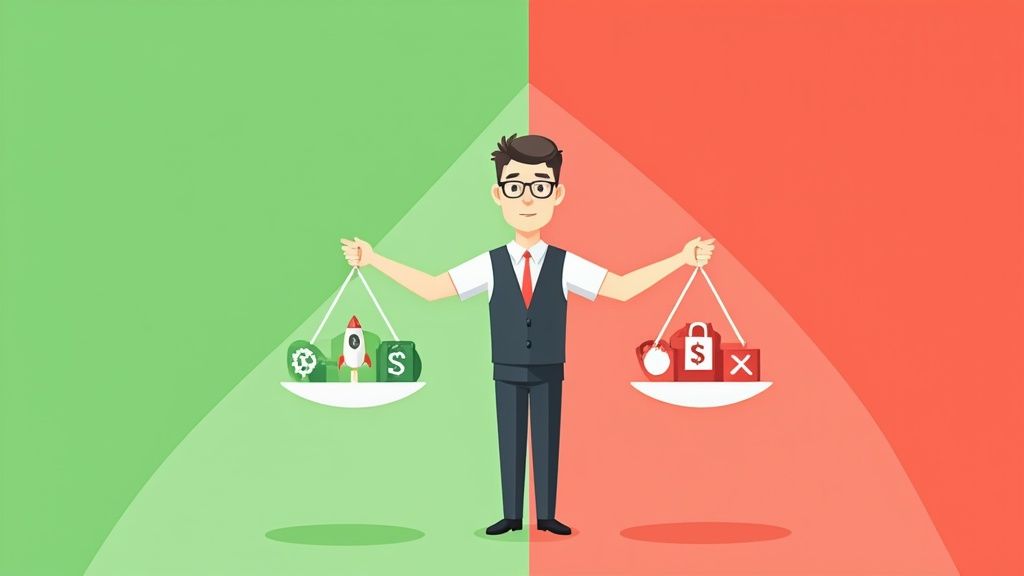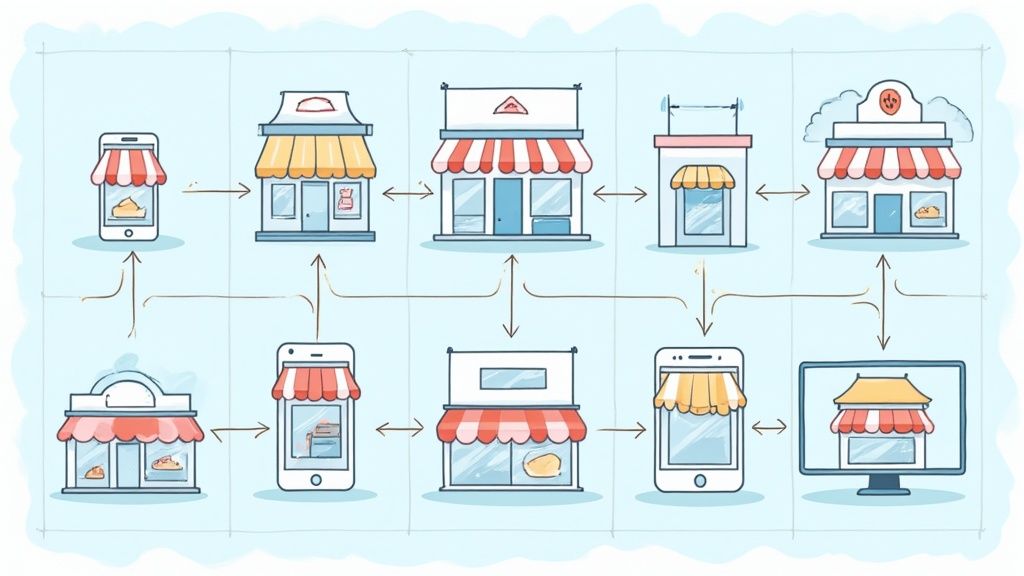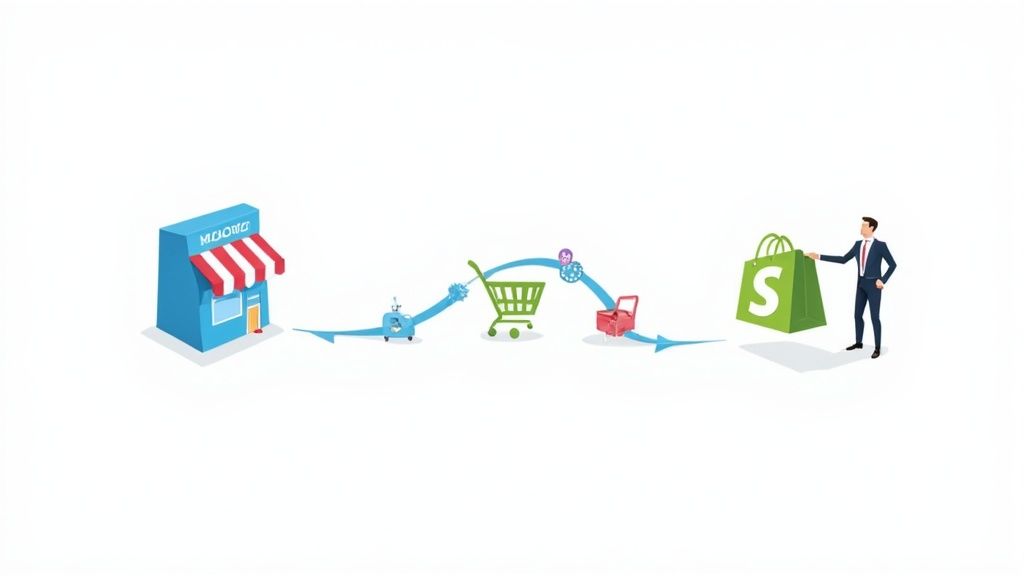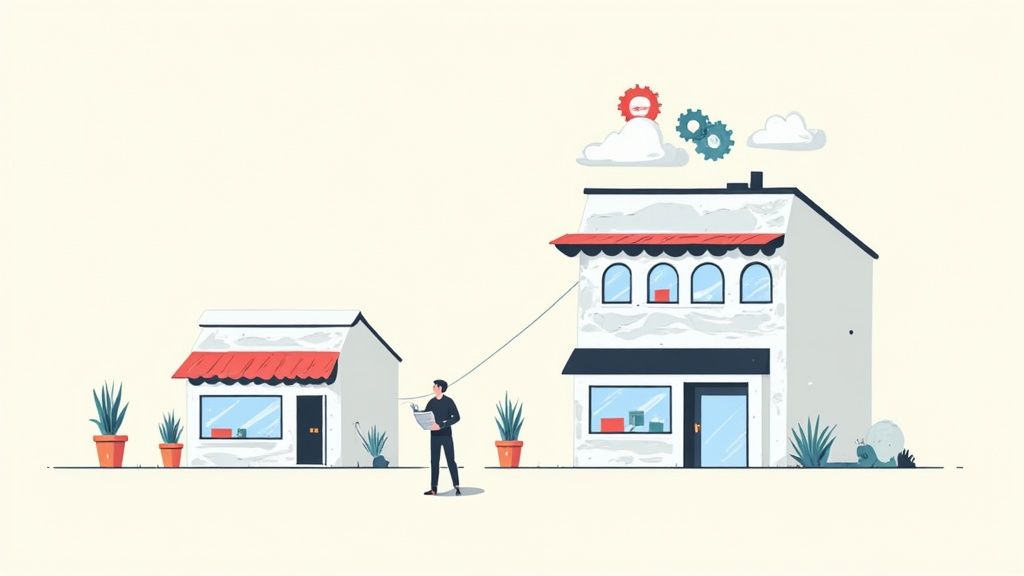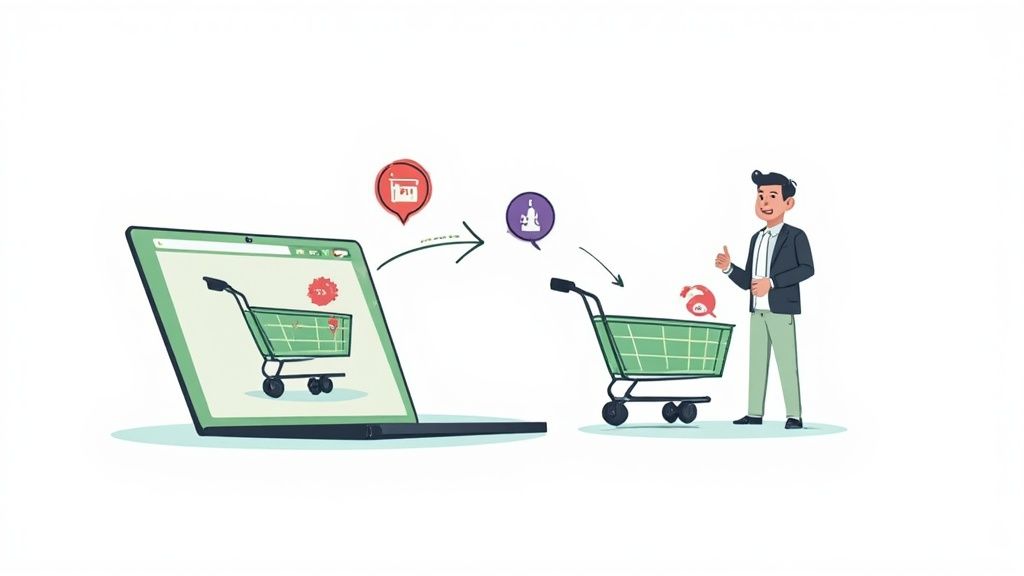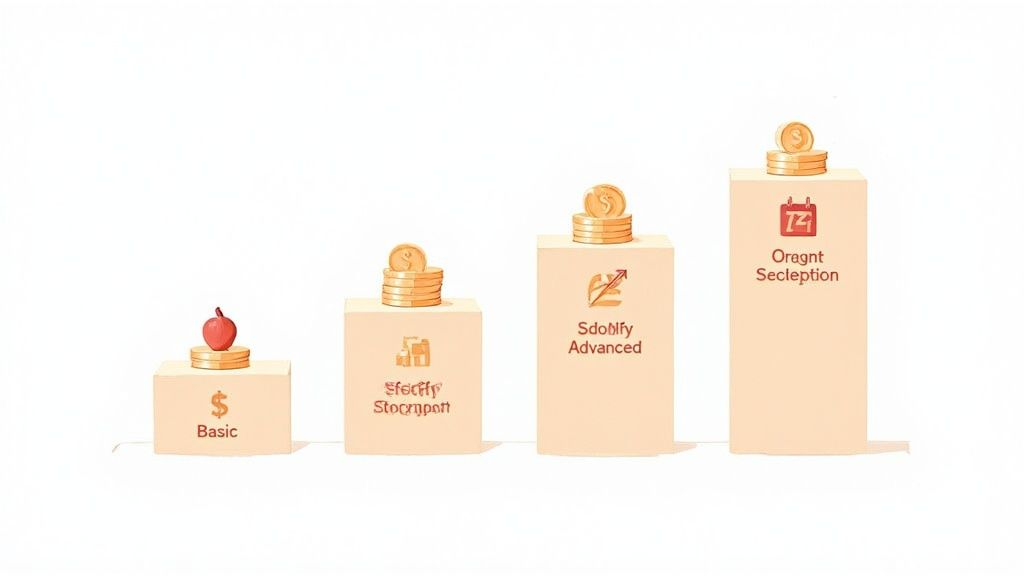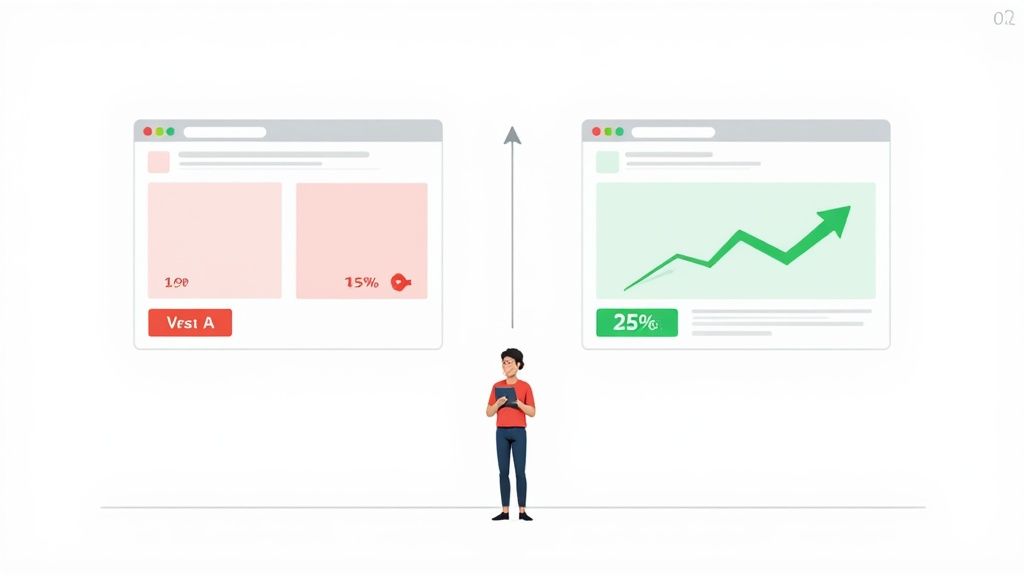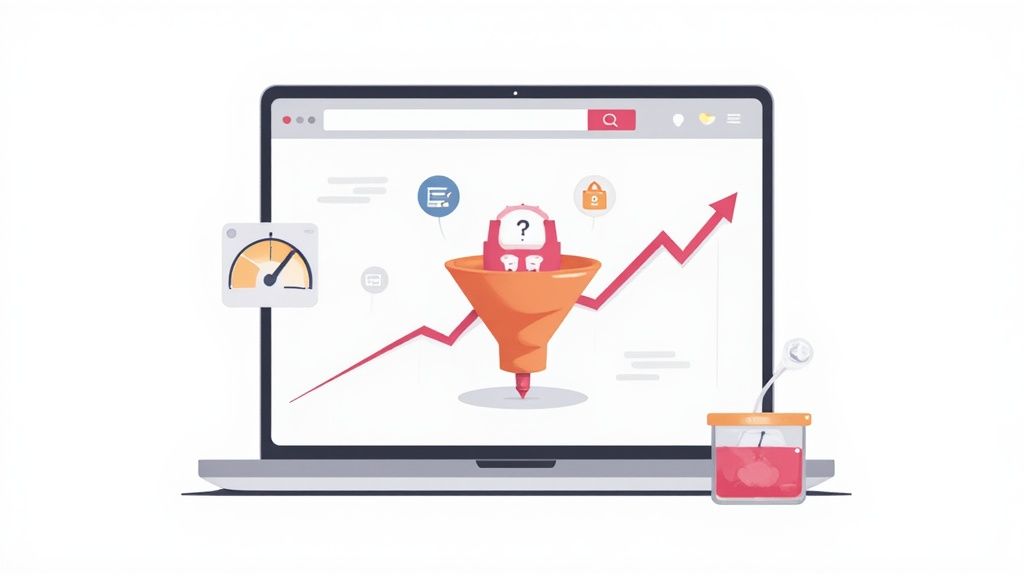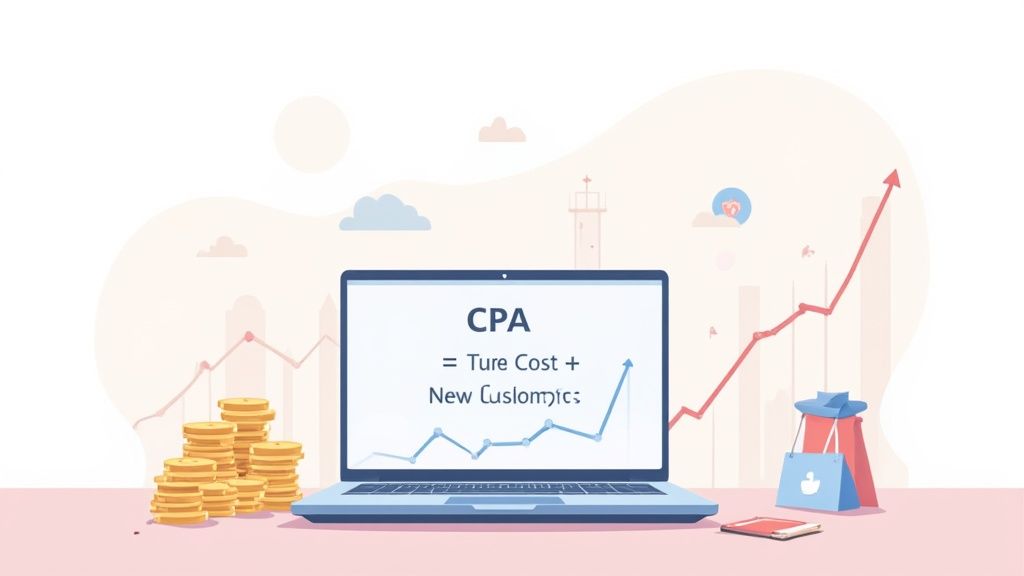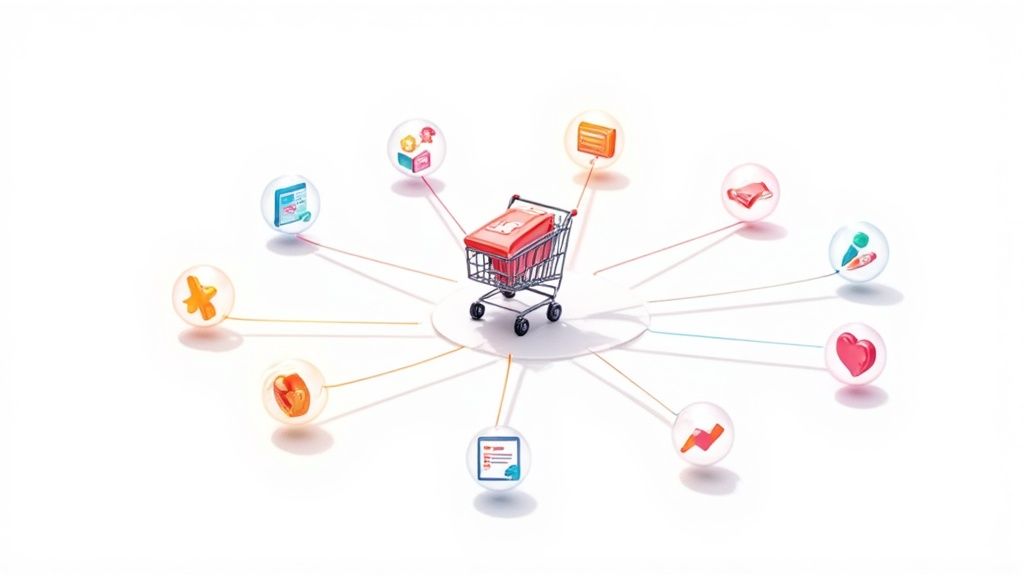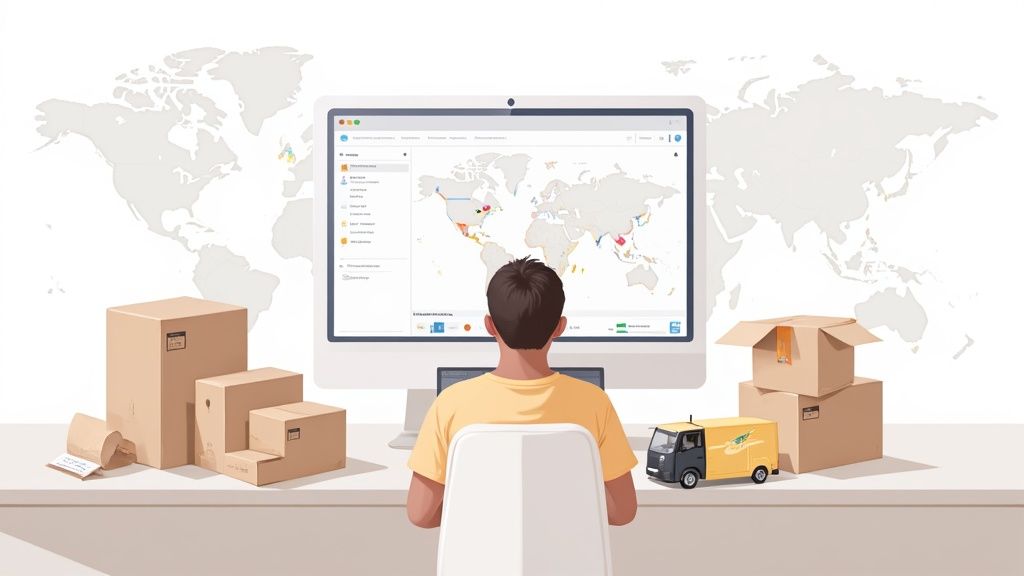
The real difference boils down to one simple question: do you want to build your own branded home online, or set up a stall in the world's biggest digital flea market?
Shopify is the toolkit for building your store, on your domain, with your rules. You own the brand, the customer relationships, and the entire experience from top to bottom. On the flip side, Amazon is a ready-made marketplace. It gives you instant access to a colossal audience that's already primed and ready to buy, but you'll be selling right alongside your direct competitors.
Choosing Your Ecommerce Battlefield
Picking between Shopify and Amazon is one of those foundational decisions that will shape your entire business. This isn't just a technical choice; it's a strategic one. Are you playing the long game, building a brand that customers will seek out by name? Or are you focused on moving units quickly by tapping into a massive, existing river of traffic? Getting clear on that answer is the first step.
This guide breaks down exactly what you need to know to make the right call. We'll dig into everything—from the nitty-gritty of fees and profit margins to the bigger picture of branding, fulfillment, and what it takes to scale. Making the right choice upfront saves you from painful migrations and strategic U-turns later on. For a wider view, it's always smart to check out comprehensive Ecommerce Resources that cover the full spectrum of online selling. And if you want to go even deeper on the platform selection process itself, our own guide on https://www.ecorn.agency/blog/how-to-choose-ecommerce-platform offers more frameworks to help you decide.
Before we dive deep, let's start with a high-level look at how these two giants stack up.
Shopify vs Amazon At a Glance
The table below gives you a quick snapshot of the core philosophical and practical differences you’ll encounter.
As you can see, the trade-offs are pretty clear. One path offers total control and brand ownership, while the other provides immediate reach at the cost of that control.
Shopify's entire value proposition is built on giving you the keys to create a unique brand experience. This is what a typical Shopify storefront can look like—clean, branded, and entirely yours.

That visual freedom is a massive differentiator. It allows merchants to craft a shopping journey that feels special and personal, a world away from the standardized, functional product listings you find on Amazon.
Understanding the Platform Models and Market Fit
Picking between Shopify and Amazon really starts with getting a handle on their core identities. This isn't just about comparing features; it's about two completely different philosophies for selling online, and that difference impacts everything you'll do as a seller. The "Shopify vs. Amazon" debate isn't about which one is better—it's about which one is built for your business.
Shopify runs on a software-as-a-service (SaaS) model. The best way to think about it is like leasing a prime commercial space and getting a complete toolkit to build your dream store from the ground up. You’re the architect, the designer, and the manager. Every single decision, from the store’s layout and branding to the entire customer experience, is in your hands. This is for entrepreneurs who want to build a real brand and own their customer relationships.
Amazon, on the other hand, is a pure marketplace. It’s less like building your own store and more like renting a booth in the world’s biggest, most chaotic shopping mall. You get instant access to a mind-boggling amount of foot traffic from people who are already there to buy something. You don’t build the store; you just list your products within Amazon’s rigid structure, competing elbow-to-elbow with thousands of other vendors.
The Landlord vs. The Marketplace Owner
A simple real estate analogy makes this crystal clear. Shopify makes you the landlord of your own building. You control the look, the feel, and who comes in the door. Yes, you’re responsible for all the marketing to get people there, but once they arrive, they are in your space, experiencing your brand without any distractions.
Amazon is the mall owner. It brings in millions of shoppers every day, but it also sets all the rules. It dictates the layout of every stall, how you can talk to customers, and even where your products show up. Your product could be sitting right next to a direct competitor, and the customer’s loyalty is almost always to the mall (Amazon), not your little stall.
Key Takeaway: Shopify gives you the tools to build a destination brand that customers actively seek out. Amazon gives you a high-traffic channel where you fight for the attention of customers who are already there to shop.
Real-World Scenarios and Business Fit
This fundamental difference means each platform is a natural fit for certain types of businesses.
- For Niche & Artisan Brands: A business selling unique, handcrafted jewelry is a perfect match for Shopify. The platform lets them tell their brand story, use stunning custom visuals, and create an entire experience that justifies a higher price. On Amazon, that same unique product would likely get drowned out by a sea of mass-produced, cheaper alternatives.
- For High-Volume Commodity Sellers: Someone selling generic phone cases or standard kitchen gadgets will often do much better on Amazon. Success there is all about price, reviews, and search visibility. You're not trying to build a deep brand connection; you're trying to win the sale with competitive pricing and fast shipping, which makes Amazon’s massive built-in audience the ideal place to be. If you fall into this camp, it's worth digging into the comprehensive pros and cons of selling on Amazon.
Market Dominance and Growth Trajectory
The numbers behind these two giants really paint a picture of the current ecommerce landscape. While Amazon's sheer size is hard to overstate, Shopify's growth trajectory shows a powerful shift towards independent commerce.
Amazon's dominance is clear, but the explosive growth in Shopify's Gross Merchandise Volume shows just how many entrepreneurs are choosing to build their own brand empires instead of just renting space in someone else's.
This chart helps visualize just how much of the market these platforms command. Discover more insights about e-commerce platform growth. What's compelling is that even as Amazon commands a huge 37.6% of U.S. ecommerce, Shopify merchants are carving out a significant and rapidly expanding piece of the pie, proving there’s more than one way to win online.
A Realistic Breakdown of Costs and Profit Margins

When you’re weighing Shopify against Amazon, looking at the advertised monthly fees is like judging an iceberg by its tip. The real story of your profitability lies in the complex web of variable fees that can swing wildly as your business scales. Getting a handle on these nuances is absolutely critical for forecasting what you’ll actually take home.
Shopify’s cost structure is, for the most part, predictable. It’s built on a foundation of fixed monthly subscriptions that give you the core software. Of course, the costs don’t stop there. For any serious business, the total monthly expense is a mix of your plan, payment processing fees, and subscriptions for essential apps.
Amazon's model is the polar opposite—it’s almost entirely variable. Instead of a set platform fee, your costs are transaction-based, scaling directly with every single sale. This can feel less risky for someone just starting out, but it can quickly become a labyrinth of fees that eat into your margins as you grow.
Shopify Costs: The Predictable Foundation
With Shopify, your main expense is the monthly subscription. These range from basic plans perfect for new ventures all the way up to Shopify Plus for enterprise-level brands. Layered on top of that are your payment processing fees.
Using Shopify Payments is the smartest move here. If you opt for a third-party gateway, Shopify will add its own transaction fee ranging from 0.5% to 2.0%, which can seriously eat away at your profits. After that, the primary variable costs on Shopify come from the app ecosystem you choose to build.
- Monthly Subscription: This is your fixed cost, the foundation of your store.
- Payment Processing: Expect to pay around 2.4% to 2.9% + 30¢ for each transaction when using Shopify Payments.
- App Subscriptions: Costs for vital apps—think email marketing, customer reviews, or advanced shipping logic—can easily add $50 to $300+ per month.
Because these costs are relatively stable, forecasting your monthly overhead is much simpler. Your main job is to drive the traffic, because your platform costs don't balloon with every sale in the same way they do on Amazon.
Amazon Costs: The Variable Labyrinth
Selling on Amazon is a "pay-to-play" game where a string of fees gets deducted from every sale you make. The biggest one is the referral fee, which is the commission Amazon takes for the privilege of selling on its marketplace. This typically runs from 8% to 15%, depending on your product category. On a $50 product, that’s a $7.50 fee gone right off the top.
And if you use Fulfillment by Amazon (FBA), you're adding another significant layer of costs. This includes fulfillment fees to cover picking, packing, and shipping, plus monthly inventory storage fees. These are calculated based on your product's size and weight and can become a huge drain, especially for items that are slow-moving or oversized.
Key Insight: On Amazon, you're not just paying for a product listing; you're paying for access to their massive built-in audience and logistics network. This trade-off means your per-unit profitability is inherently lower, forcing you to chase higher sales volume to hit the same net profit you could on a Shopify store.
Here’s a quick look at Amazon's main fee structure:
The tipping point usually arrives when a business starts to scale. A brand-new startup might be drawn to Amazon’s low barrier to entry. But as revenue climbs, Shopify's fixed-cost model and lower per-transaction fees often become far more profitable—especially when you remember you also get to own your customer data.
Reaching Your Customers Where They Shop
The core difference between Shopify and Amazon boils down to one question: are you building your own highway, or are you setting up a stall on the busiest highway in the world? How you find and attract customers will look completely different depending on your answer.
Amazon is a marketplace built on intent. With over 310 million active customers, it acts less like a store and more like a massive, product-focused search engine. Shoppers don't land on Amazon to window shop; they arrive with a specific need and a credit card in hand. Success here is a science of winning visibility inside a closed ecosystem.
This means your marketing isn't about driving traffic from Google or social media. It's about mastering Amazon's internal game to win over the eyeballs already on the site.
Winning on Amazon: A Game of Internal Optimization
To stand out on Amazon, you have to pour your energy into three key areas:
- Amazon SEO (A9 Algorithm): This is all about optimizing your product titles, descriptions, and backend keywords to rank higher in Amazon’s search results. You’re essentially convincing Amazon's A9 algorithm that your product is the best answer to a customer's query.
- Winning the Buy Box: An estimated 82% of Amazon sales happen through the "Buy Box." Getting this coveted spot is non-negotiable and hinges on competitive pricing, great seller metrics, and using Fulfillment by Amazon (FBA).
- Sponsored Product Ads: With competition this fierce, paying for visibility through Amazon’s PPC platform is pretty much essential. It’s a direct cost you have to factor in just to get your product in front of ready-to-buy shoppers.
On Amazon, the audience is a given, but their attention must be earned through relentless, platform-specific work. You're a tenant in their world, playing by their rules to capture a piece of their traffic.
Building an Audience with Shopify: A Long-Term Asset
Shopify flips this model on its head. Here, you are the architect of your own audience. Shopify gives you the tools to build your store, but it’s entirely up to you to bring people to it. This demands a much more diverse, external marketing strategy, but the reward is an asset you own outright—your customer list.
Owning your audience means you aren't vulnerable to algorithm changes on a third-party platform. Your email list, social media followers, and organic search traffic are direct lines of communication with your customers that no marketplace can take away.
This strategy is about building a brand that people actively look for. It's a longer game, for sure, but it creates a much more defensible business in the long run. Among the top 1 million e-commerce sites, Shopify already holds a 28.8% market share, showing its power among merchants who are successfully building their own brands. You can dig deeper into Shopify's growing dominance in the ecommerce space.
The journey to building that audience usually involves a mix of these strategies:
- Search Engine Optimization (SEO): Creating blog content and optimizing product pages to rank on Google, catching customers right when they start their buying journey.
- Content Marketing: Building a blog, a YouTube channel, or a podcast that provides real value and establishes your brand as an authority in its niche.
- Paid Social and Search: Running targeted ads on platforms like Facebook, Instagram, and Google to reach new customers based on their interests and online behavior.
- Email Marketing: Building an email list to nurture leads and drive repeat purchases, creating a direct and highly profitable communication channel.
While this path requires more upfront marketing muscle and budget, the result is a loyal customer base and total control over your brand’s destiny. For businesses wanting to play in both sandboxes, learning how to connect Shopify to Amazon can create a powerful hybrid strategy, giving you the best of both worlds.
Building a Brand vs. Selling a Product
Your brand is much more than just a logo. It's the entire feeling you give a customer, shaping every single interaction from the moment they discover you to the post-purchase thank you email.
When you stack up Shopify vs. Amazon, the potential for true brand building is one of the starkest differences between them.
Shopify gives you a blank canvas. You control the themes, the checkout flow, the entire customer journey. Amazon, on the other hand, confines your brand message to its standardized store framework and A+ Content modules. You're playing in their sandbox, by their rules.
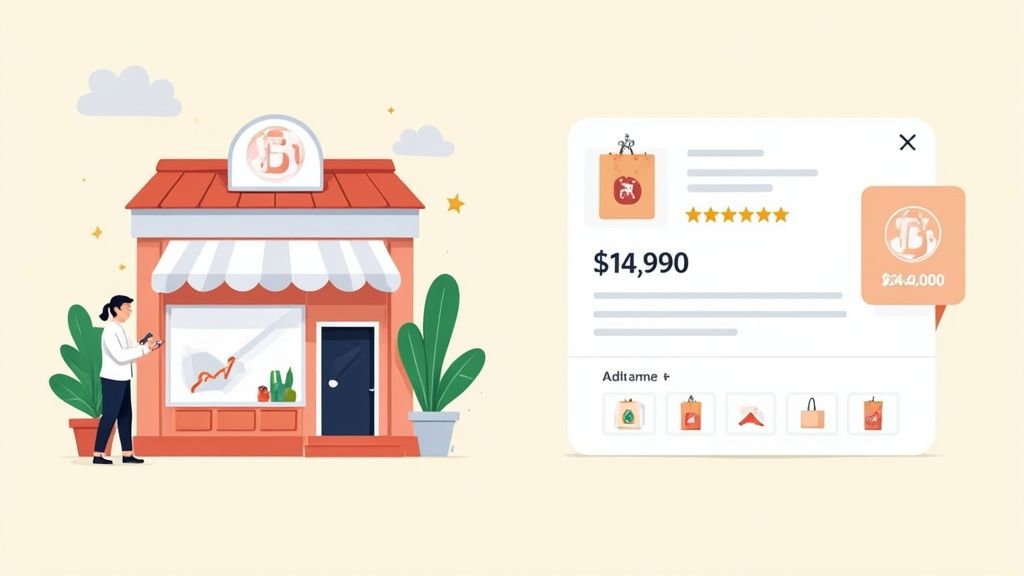
Let's break down the key contrasts quickly:
- Shopify: You get complete design control, from your homepage right down to the cart and checkout.
- Amazon: You get A+ pages and a basic storefront, but that’s about it.
- Shopify: The app ecosystem lets you create personalized upsells, email flows, and loyalty programs.
- Amazon: Your ability to customize is strictly limited by marketplace guidelines.
Customization and Storytelling
With Shopify, you can weave a narrative that's uniquely yours. Think about an artisan candle brand. On their Shopify store, they can use custom fonts, immersive video banners, and rich storytelling to truly justify a premium price point.
Or imagine a handcrafted jewelry shop embedding behind-the-scenes videos of their process and adding interactive size guides. This kind of brand immersion builds a real connection, fostering the loyalty that leads to repeat business.
“Building a brand on Shopify means every touchpoint reflects your identity. On Amazon, your story has to live within a very rigid, predefined structure,” says ECORN’s lead strategist.
Speed and Sales Velocity
Now, let's talk about Amazon's superpower: pure sales velocity. If you're selling a more generic item, like a phone case, you can instantly tap into an audience of 310 million active customers. Using Fulfillment by Amazon (FBA) handles storage, shipping, and returns, making it a turnkey solution for driving high volume quickly.
The catch? The intense competition often leads to a race to the bottom on price. To succeed, you have to constantly optimize your pricing, cultivate reviews, and master Amazon SEO just to maintain your advantage in the Buy Box.
- You'll want to use FBA to get that Prime eligibility, which significantly boosts conversion rates.
- Don't forget to factor in referral fees, which typically run 8–15%, plus all the associated fulfillment charges.
- To stand out, you'll need to leverage Amazon ads and deals for crucial bursts of visibility.
This means businesses focused on rapid sales cycles and commodity-type products often thrive on Amazon. On the flip side, companies building a distinct identity and aiming for a higher customer lifetime value almost always gravitate toward Shopify.
Making the Strategic Choice
Choosing between Shopify and Amazon really comes down to your core goals and what you're selling. A new health supplement brand that needs to build credibility and customer loyalty would likely invest in Shopify for its customization and conversion rate optimization (CRO) capabilities.
In contrast, a gadget reseller chasing massive scale and predictable logistics might lean heavily on Amazon’s marketplace reach and FBA network.
- Identify your primary objective: Is it building long-term brand equity or achieving rapid sales volume?
- Assess your technical needs: Do you need a fully custom checkout experience, or is a standard marketplace integration sufficient?
- Plan your marketing mix: Will you focus on SEO and content marketing (Shopify) or rely on sponsored ads within a marketplace (Amazon)?
- Consider a hybrid approach. Many successful brands use Shopify as their central brand hub while leveraging Amazon as a high-volume sales channel.
Here at ECORN, our expertise is in helping brands navigate these decisions. We can guide you through migrations, implement powerful CRO improvements, or build out robust Shopify Plus experiences. It all starts with a tailored audit to align the right platform capabilities with your business strategy.
Comparing Fulfillment and Logistics Strategies
How you get your products into customers' hands is just as important as how you sell them. In ecommerce, fulfillment can either be your biggest competitive edge or your most painful operational headache. This is one of the most critical battlegrounds in the Shopify vs. Amazon debate because their approaches couldn't be more different.
Amazon’s Fulfillment by Amazon (FBA) is an absolute logistics powerhouse. It's a nearly complete, hands-off solution: you ship your inventory to their warehouses, and they take over everything else—storage, picking, packing, shipping, and even customer service for any fulfillment hiccups.
For a lot of sellers, FBA is the main attraction. The convenience is hard to argue with, and signing up instantly gets you that coveted Prime badge, a massive symbol of trust and speed that can seriously boost conversions.
The Power and Price of Amazon FBA
Using FBA means plugging your business into one of the most sophisticated logistics networks on the planet. Your products immediately qualify for two-day Prime shipping, which is a powerful psychological trigger for Amazon's millions of loyal customers.
But this convenience doesn't come cheap, and it definitely comes with strict rules. FBA is a complex maze of fees that can eat into your margins fast if you aren't paying close attention.
- Fulfillment Fees: Charged per unit, these vary based on your product’s size, weight, and category.
- Storage Fees: You pay a monthly fee for the space your inventory takes up, and these costs jump significantly during peak shopping seasons.
- Long-Term Storage Fees: If your products don't sell and just sit there, Amazon hits you with punitive fees to free up their warehouse space.
- Inventory Requirements: Amazon has very specific guidelines for how your products need to be prepped and labeled before they'll even accept them at their fulfillment centers.
At its core, FBA is built for speed and volume. It’s a perfect fit for standardized, fast-selling products where the benefit of the Prime badge is worth more than the per-unit costs and the loss of brand control.
Shopify's Flexible Fulfillment Framework
Shopify gives you the complete opposite of Amazon's rigid, all-in-one system: total flexibility. You’re in the driver's seat, totally free to build a fulfillment strategy that fits your brand, your budget, and your scale.
This control is a huge deal because it lets you create a branded shipping experience. Think custom packaging, personalized inserts, and thank-you notes—things that are simply impossible with FBA's generic brown boxes.
Key Differentiator: With Shopify, fulfillment is part of your brand experience. With Amazon FBA, fulfillment is a utility provided by the marketplace, standardizing the final, critical touchpoint with your customer.
Here’s a look at the main fulfillment options Shopify merchants can choose from:
Global Reach and Strategic Considerations
Your choice here also impacts how you grow internationally. Amazon’s global infrastructure is unmatched, offering a direct line into emerging markets. That said, Shopify's ecosystem is quickly catching up. The Asia-Pacific region is the world's largest e-commerce market, valued at $4.2 trillion. While most of Shopify's revenue still comes from North America, its network of 3PL partners gives merchants the flexibility to reach customers anywhere in the world. Discover more insights about the global e-commerce market.
Ultimately, the decision boils down to a classic trade-off: convenience versus control. FBA offers a powerful, turnkey solution if your goal is high volume and speed within the Amazon ecosystem. Shopify, on the other hand, gives you the freedom to build a logistics strategy that’s a true extension of your brand, letting you own the entire customer journey from click to delivery.
Making the Final Decision for Your Business
Choosing between Shopify and Amazon isn't about finding the "better" platform. It’s about being brutally honest about your business's DNA and picking the platform whose strengths match your own.
All the side-by-side comparisons of fees, fulfillment, and features really boil down to one strategic question: are you building a long-term brand asset or launching a high-velocity sales channel? Your answer changes everything.
The right decision really hinges on four pillars: your product, your budget, your brand ambitions, and your timeline. A clear-eyed look at these factors will make the path forward pretty obvious.
A Framework for Your Decision
To cut through the noise, let’s look at a few common scenarios. See which one sounds most like your business—each has a clear winner in the Shopify vs. Amazon debate.
You're testing a new product idea with a limited budget. Go with Amazon. It’s the perfect launchpad. You can plug directly into a massive, purchase-ready audience without a huge upfront investment in brand building and traffic generation. It’s all about validating demand, fast.
You're building a unique brand with a strong story. It has to be Shopify. This is the only real choice if you want a blank canvas to create a custom experience, own your customer relationships, and control your brand’s narrative from top to bottom. This is the long game.
Your main goal is maximum sales volume for a standardized product. Amazon FBA and the Prime badge are completely unmatched here. The entire platform is a machine built for high-volume sales, and its logistics network makes scaling a breeze for products that compete on price and availability.
Your choice is a trade-off between control and convenience. Shopify gives you total control over your brand and your destiny. Amazon offers unparalleled convenience and immediate market access. Understanding which one you value more is the key.
This decision tree breaks it down even further, especially when you think about your fulfillment goals.

As you can see, sellers who prioritize operational control and a branded experience will find Shopify to be a much better fit. Those who are looking for more of a hands-off approach to logistics will naturally gravitate toward Amazon.
The Hybrid Model: When to Use Both
Here's the thing: you don't actually have to choose just one. Many of the most successful brands today run a hybrid model, playing to each platform's strengths.
Shopify as the Hub, Amazon as the Spoke:
This is, by far, the most effective multi-channel strategy we see. Your Shopify store acts as your central brand hub—it’s home base for your content, your customer data, and your highest-margin sales. You then use Amazon as a powerful acquisition channel to reach customers who might never have discovered you otherwise.
This approach truly gives you the best of both worlds: the brand equity and customer ownership of Shopify, combined with the immense, undeniable reach of Amazon.
Whether you're just launching, planning a migration, or ready to scale, making the right platform choice is foundational. If you're looking to build a powerful Shopify Plus store or need to optimize your current one for higher conversions, the experts at ECORN can provide the strategic guidance and development support you need to get it right.
Frequently Asked Questions
When you're weighing Shopify against Amazon, the right choice really boils down to your specific business, your goals, and how you want to grow. Let's tackle some of the most common questions we hear from merchants trying to make this exact decision.
Is Shopify or Amazon Better for Beginners?
If you're a complete newcomer to eCommerce, Amazon offers a much smoother on-ramp. It comes with a massive, ready-made audience of buyers, which means you can skip the marketing lessons (for now) and focus purely on sourcing great products and making your listings shine. Plus, with FBA, the entire complex world of logistics is handled for you right out of the gate.
That said, Shopify is the better starting point for beginners who are passionate about building a brand, not just selling a product. Yes, there's a steeper learning curve when it comes to generating your own traffic. But the platform itself is incredibly intuitive, and you'll learn priceless skills about marketing and customer relationships that will serve you for years to come.
Should I Sell on Both Shopify and Amazon?
For many growing businesses, the answer is a resounding yes. In fact, a hybrid approach is often the smartest way to scale. Think of it like this: Shopify is your central brand hub, the place where you own the customer relationship, control the experience, and enjoy the highest profit margins.
At the same time, you can leverage Amazon as a powerful sales and customer acquisition channel. It's a fantastic way to get your products in front of millions of shoppers who might not have found your brand otherwise. The key to making this work is a rock-solid inventory management system that keeps your stock levels synced across both channels. Without it, you risk overselling and creating a logistical nightmare.
Navigating the complexities of a Shopify Plus build, a full-scale migration, or fine-tuning your conversion rate isn't something you should do alone. ECORN brings the strategic guidance and hands-on development needed to make sure your platform choice is a perfect match for your ambitions. Explore our Shopify solutions and let's build a store that's ready to scale.






